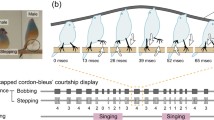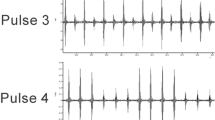Abstract
The males of allDrosophila virilis-group species produce primary courtship song; and the males of four of these species also provide secondary courtship song when courting a female. The amount of secondary song and the courtship phase at which it is produced vary according to the species.D. lummei males produce secondary song consisting of successive 12-ms-long sound pulses with 70-ms-long intervals between pulses.D. borealis males produce short and dense pulse trains andD. littoralis andD. flavomontana males produce single sound pulses of a long duration (80–160 ms). The males of all species produce pulse-structured inhibitory song when they are courted by another male. In the secondary and inhibitory songs of interspecific hybrids, short and dense pulse trains of parent species break into pulse song with long interpulse intervals. This suggests that songs consisting of short and dense pulse trains and pulse songs with long interpulse intervals are just different modes of the same song. Sine songs (long sound pulses) seem to be inherited independently of pulse song.
Similar content being viewed by others
References
Asada, N., Fujiwara, K., Ikeda, H., and Hihara, F. (1992). Mating behavior in three species of theDrosophila hypocausta subgroup.Zool. Sci. 9:397–404.
Bennet-Clark, H. C., and Leroy, Y. (1978). Regularity versus irregularity in specific songs of closely-related drosophilid flies.Nature 271:442–444.
Chang, H.-C., and Miller, D. D. (1978). Courtship and mating sounds in species of theDrosophila affinis subgroup.Evolution 32:540–550.
Cowling, D. E., and Burnet, B. (1981). Courtship songs and genetic control of their acoustic characteristics in sibling species of theDrosophila melanogaster subgroup.Anim. Behav. 29:924–935.
Crossley, S. A. (1986). Courtship sounds and behaviour in the four species of theDrosophila bipectinata complex.Anim. Behav. 34:1146–1159.
Crossley, S. A. (1990).Drosophila pulse and sine songs and their evolution.Behav. Genet. 20:714 (abstr.).
Everitt, B. S. (1977).The Analysis of Contingency Tables, John Wiley, New York.
Ewing, A. W. (1979). Complex courtship songs in theDrosophila funebris species group: Escape from an evolutionary bottleneck.Anim. Behav. 27:343–349.
Ewing, A. W., and Miyan, J. A. (1986). Sexual selection, sexual isolation and the evolution of song in theDrosophila repleta group of species.Anim. Behav. 34:421–429.
Hoikkala, A. (1985). Evolution of the male courtship sound in the species of theDrosophila virilis group.Acta Univ. Ouluensis A. 175 Biol. 25.
Hoikkala, A., and Liimatainen, J. (1992). Competitive mating success and attractiveness of sterile and fertile males ofDrosophila montana.Ethology 91:122–133.
Hoikkala, A., and Lumme, J. (1987). The genetic basis of evolution of the male courtship sounds in theDrosophila virilis group.Evolution 41:827–845.
Hoikkala, A., Lakovaara, S., and Romppainen, E. (1982). Mating behavior and male courtship sounds in the Drosophila virilis group. In Lakovaara, S. (ed.),Advances in Genetics, Development and Evolution of Drosophila, Plenum, New York, pp. 407–421.
Hoikkala, A., Kaneshiro, K. Y., and Hoy, R. R. (in press). Courtship songs of the picture-wingedDrosophila planitibia subgroup species.Anim. Behav.
Hoy, R. R., Hoikkala, A., and Kaneshiro, K. (1988). Hawaiian courtship songs: Evolutionary innovation in communication signals inDrosophila.Science 240:217–219.
Ikeda, H. (1985). Nature of the sound produced by courtship-inhibiting behavior of the male.Drosophila mercatorum.Experientia 41:1197–1199.
Ikeda, H., Takabatake, I., and Sawada, N. (1980). Variation in courtship sounds among three geographical strains ofDrosophila mercatorum.Behav. Genet. 10:361–375.
Lakovaara, S. (1969). Malt as a culture medium for Drosophila species.Dros. Info. Serv. 44:128.
Lee, R. C. P. (1986). The role of male song in sex recognition inZaprionus tuberculatus (Diptera, Drosophilidae).Anim. Behav. 34:641–648.
Liimatainen, J., Hoikkala, A., Aspi, J., and Welbergen, Ph. (1992). Courtship inDrosophila montana: the effects of male auditory signals on the behaviour of flies.Anim. Behav. 43:35–48.
Paillette, M., Ikeda, H., and Jallon, J.-M. (1991). A new acoustic signal of the fruit-fliesDrosophila simulans andD. melanogaster.Bioacoustics 3:247–254.
Satokangas, P., Liimatainen, J. O., and Hoikkala, A. Songs produced by the females of theDrosophila virilis group species.Behav. Genet. (in press).
Sokal, R. R., and Rohlf, F. J. (1981).Biometry, 2nd ed., Freeman, San Fransisco.
von Schilcher, F. (1976). The role of auditory stimuli in the courtship ofDrosophila melanogaster.Anim. Behav. 24:18–26.
Waldron, I. (1964). Courtship sound production in two sympatric sibling Drosophila species.Science 144:191–193.
Welbergen, Ph., van Dijken, F. R., and Scharloo, W. (1987). Collation of the courtship behaviour of the sympatric speciesDrosophila melanogaster andD. simulans.Behaviour 101:253–274.
Zar, J. H. (1984).Biostatistic Analysis, int. ed., Prentice Hall; Englewood Cliffs, NJ.
Author information
Authors and Affiliations
Rights and permissions
About this article
Cite this article
Suvanto, L., Hoikkala, A. & Liimatainen, J.O. Secondary courtship songs and inhibitory songs ofDrosophila virilis-group males. Behav Genet 24, 85–94 (1994). https://doi.org/10.1007/BF01067932
Received:
Accepted:
Issue Date:
DOI: https://doi.org/10.1007/BF01067932




